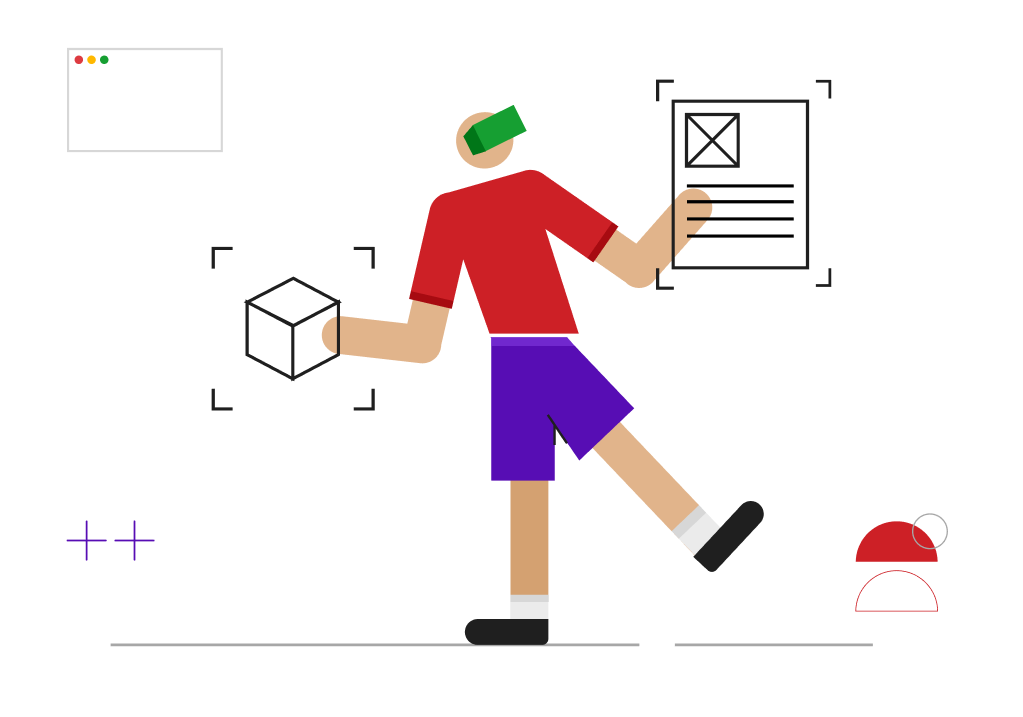This projects explain how we at Designerrs Lab followed a design thinking approach towards solving a problem which is very existential in our society amongst kids.
Identification of the problem
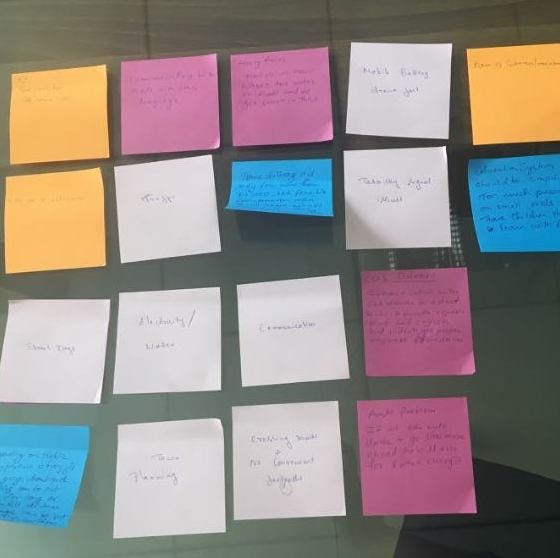
We started with listing out common problems we face in our daily lives in home, workplaces, while commuting etc. We listed down around 50 problems in total and conducted a group voting session to categorize similar problems, we then narrowed down to some on the basis of the prevalence of the problem and how much social impact can be created by solving that problem. Being responsible is a key to children’s success both in school and in the larger world when they grow up. We felt this as a major problem in present day world where we need children to grow up as responsible citizens. So the initial design challenge/ problem was:
How can we make children’s more responsible in different life situations?
Empathizing with the user
We started with doing some initial secondary research to build some domain knowledge regarding this chosen topic and get inspiration to start with primary research. We tried to understand parents-children relationship, children psychology and children view on responsibility, also what are the general expectation of parents from their children by going through previous research papers, newspapers, magazines and journals and even YouTube videos. Based on this secondary research, we created a questionnaire to investigate about our potential user’s needs, motivations and frustrations and conducted 10–12 semi-structured interviews with varied group of parents and children (5–10 years old) keeping gender and occupation as diverse as possible.
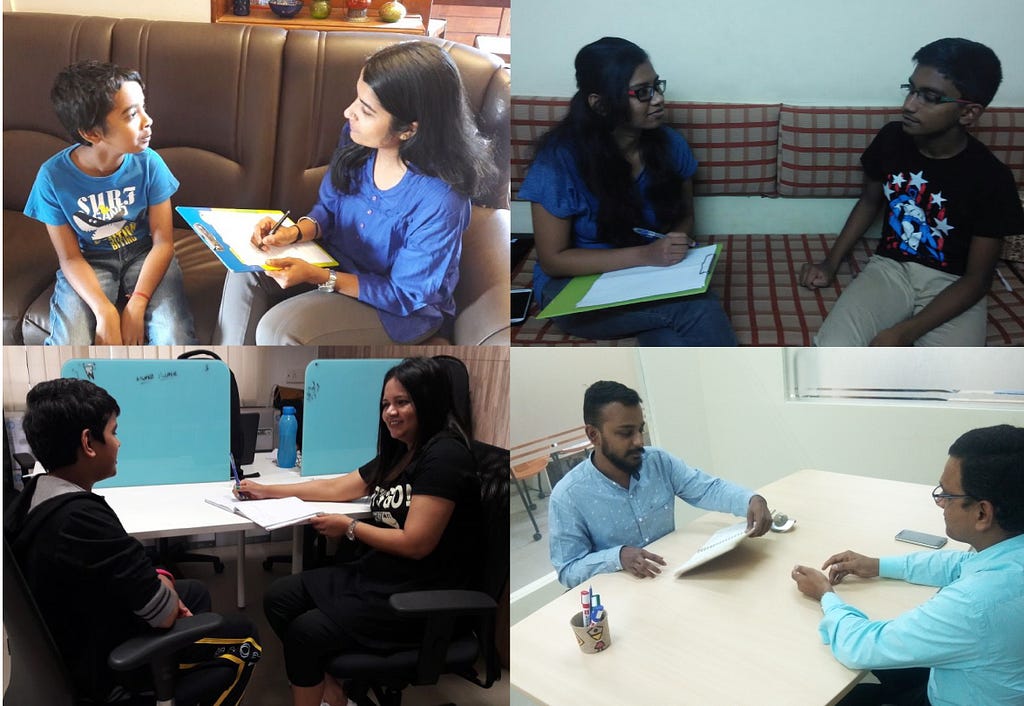
Synthesizing Research
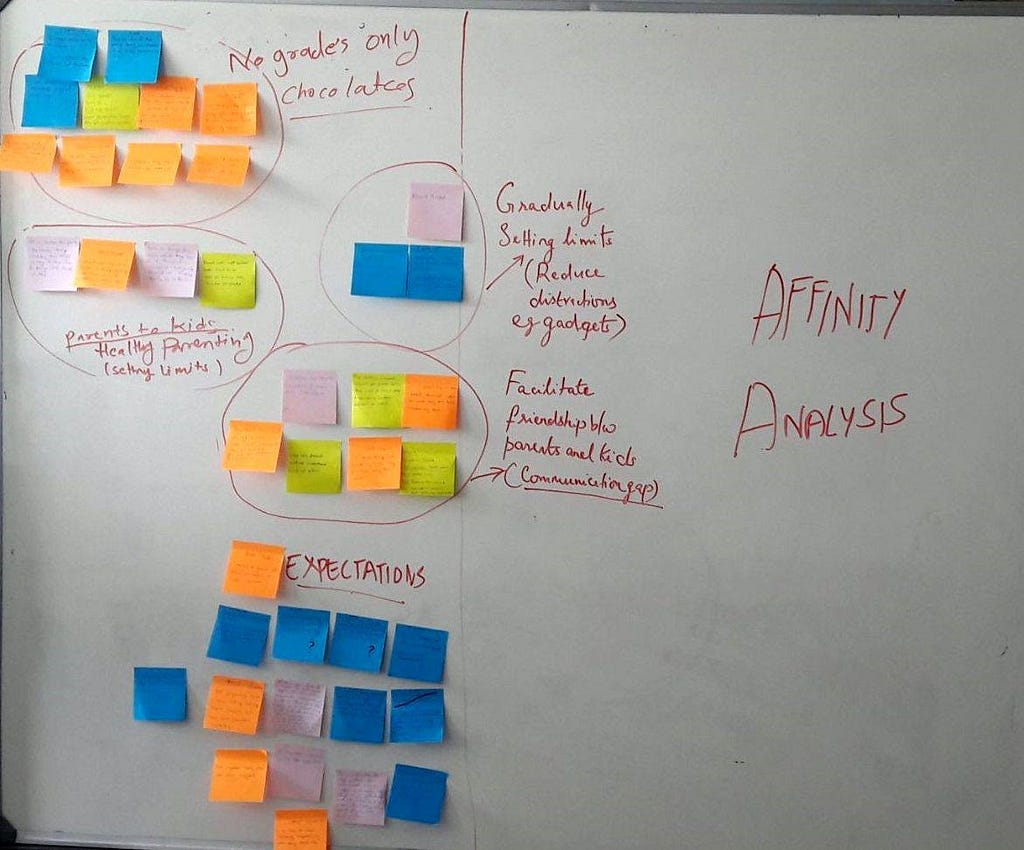
Now since we had some much data and understanding about our users, we started analyzing and synthesizing insights from our research using Affinity Analysis. We found out patterns and behaviors of parents and kids and categorized them to generate certain insights. Following are our insights from the research:
No grades only chocolates
“Children completes the tasks only if they are rewarded”, we found this a main user problem that the grading system have a negative impact on children. Instead of bigger or smaller rewards, every kid should be appreciated in its own way.
Facilitate communication between parents and children
“I share secrets with parents if I feel they don’t scold then only I share”, the user statements revealed that parents find their children sharing their problems only with their friends and are more close to them. Through our primary and secondary research we concluded that a healthy relationship should be maintained between parents and kids.
Promoting Healthy parenting
“We should not do too much spoon-feeding to kids, sometimes we should allow kids to do mistakes and learn from it”, during our conversation we came to know that many parents lacks a healthy parenting style. They are not close to their kids but set limits which makes the kids do not share their problems with their parents. Studies always show following a healthy parenting style is very crucial for a child’s personal development.
Gradually setting limits
“My son is absent minded, his mind will be on games all the time”, majority of the parents complained about the time spent on gadgets by the kids which makes them irresponsible. This statement is being supported by many recent studies on the ill effects of prolonged use of gadgets by kids. But technology was not initially meant to harm kids or society in general. Misuse/ Overuse leads to harmful effects but if used properly it can help kids to learn in a better way. At the end of affinity analysis, we had an understanding of our potential users and so we created personas, we also understood the context of the user by writing their user stories and redefined our problem statement based on the research.
Redefining the Problem Statement
After getting deeper insights on the topic, we realized that problem statement need to be redefined. We identified that parents have a major influence on kids of 5–10 years old and our potential users are not just kids but parents as well.
“We used the POV (Point of view) method to re-frame our design challenge into a more human centered actionable problem statement. The redefined actionable problem was Parents need to be more friendly and communicative to their kids so that kids can become self-dependent for their daily tasks”.
User Personas and Stories
Based on the user research we created certain personas which helped us cater to most of our potential users and keep these users at the center while making any design decision. We also created user stories to understand context of our users through a typical day in their life.
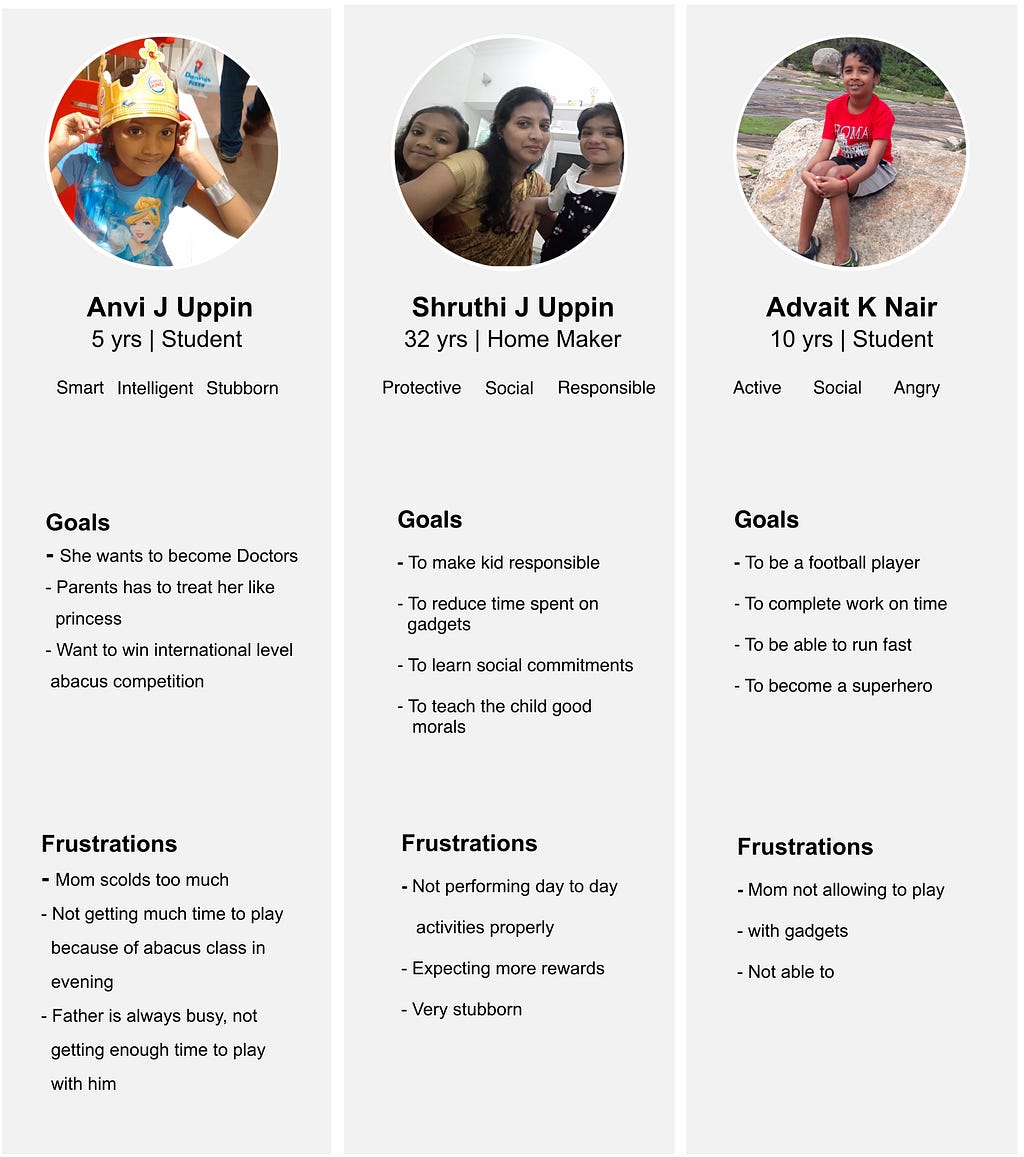
Here is the link to the user stories.
How Might We (HMW’s)

Based on the problem statement, insights and personas identified in the research, we created How Might We questions to bridge the gap between insights and ideas. HMW’s helped us think out of the box ideas in different directions. Below are the HMV questions we made: 1.How might we make the kids to be courageous and brave? 2. How might we make the kids to perform task without expecting rewards? 3. How might we make parents to set less expectations from kids? 4. How might we reduce kids gadget time and utilise that time for better tasks? 5. How might we reward a kid for performing their task? 6. How might we build friendly relation while telling moral stories to kids? 7. How might we use childrens play time to teach them good things? 8. How might we use kids energy for productive tasks? 9. How might we make children learn from their own mistakes? 10. How might we make children to involve in daily tasks of parents? 11. How might we make parent and child as best buddies? 12. How might we guide parents to talk softly and politely with love and affection to kids? 13. How might we engage parents and kids in their free time?
Brainstorming about ideas
Based on the How Might We questions created we started brainstorming to generate wild, creative, child like ideas for each HMW question. We focused more on quantity than quality of the ideas in this step.

Narrowing down solutions
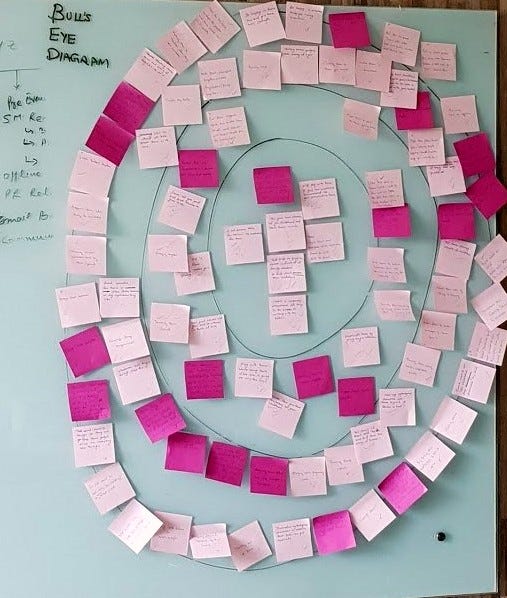
Now since we had a lot of different ideas that solve some individual part of the problem, the next task was to identify the priorities and possibilities of each solution to move forward. We voted each solution and categorized the solutions into primary, secondary and tertiary in the Bull’s Eye Diagram. Primary circle of the diagram had the most voted solutions. We derived design directions from the solutions which were in primary circle of Bull’s eye diagram.

Information Architecture
Keeping design directions and the design principles in mind we organized and structured the information identified from our research regarding the kind of responsibilities parents expect from their children. We started listing down the activities and behavior parents expect from children in different situations like home (brushing teeth etc), school (friendly behavior), outdoor etc.
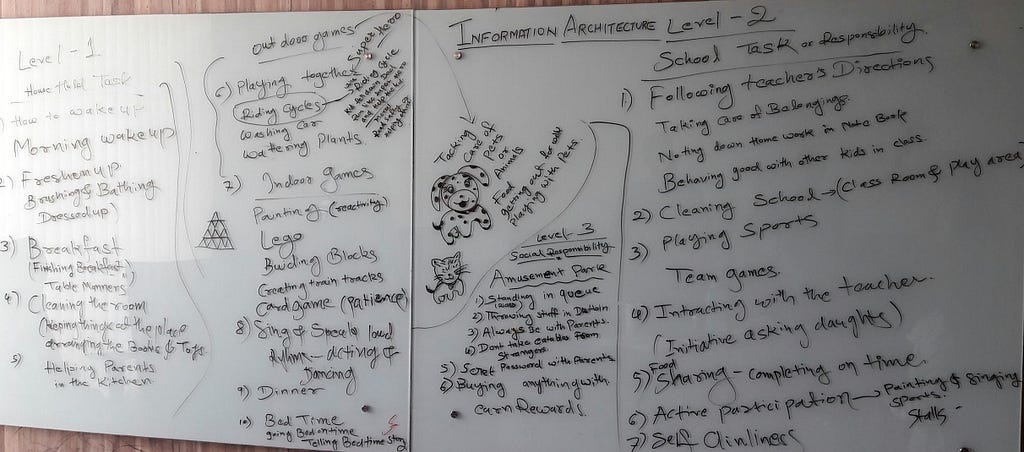
Storyboarding and Wireframing

Now the challenge was how to make the kids do these activities as well make them learn. We started thinking of how we could use technology to solve these problems in users daily life. We finalized on a solution which uses Augmented Reality (AR) and Gamification techniques which makes these boring monotonous activities more fun, engaging and immersive. We conceptualized a Mixed reality headset based game using which kids can live their imagination and perform the tasks assigned by parents (using tablet) in the real environment. We included different levels for the game and made it interesting by including superheroes and cartoon characters which teach kids different kinds of responsibility in different scenarios as well reward the kid and makes the game more interesting and fun for them.
High Fidelity Mockups
We have conceptualized a specific use case of a kid brushing teeth in front of mirror and have also made high fidelity mockups of such a mixed reality scenario.

Increasing responsibilities amongst children through Mixed Reality was originally published in DSchool on Medium, where people are continuing the conversation by highlighting and responding to this story.
